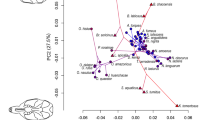Abstract
Morphological disparity, the measure of morphological variation among species and higher taxa, has been at the core of an important research program in paleobiology over the last 25 years. Its quantification is based on the construction and exploration of morphospaces, multidimensional spaces spanned by a set of morphological descriptors, and benefits from a well-established analytical protocol. Two main classes of indices are routinely used to describe the distribution of taxa in morphospace in terms of their spread and spacing. This unique focus on the morphological component of clade dynamics has promoted disparity as a distinct measure of biodiversity complementing traditional taxonomic proxies. Disparity studies have led to improved understanding of the evolutionary history of major clades and fostered new research on adaptive radiations, rates of evolution, and morphological innovation. Currently, active areas of methodological development focus on characterizing the geometric properties of morphospaces, devising indices that describe the structure of disparity, and incorporating phylogenetic information. There have also been increasing efforts to identify the determinants of disparity, from developmental to functional and ecological considerations, leading to conceptual extensions such as allometric disparity. The importance of trends, extinction, and chance as factors in the evolution of disparity remains relatively underexplored and needs more attention.
Melanie J. Hopkins and Sylvain Gerber contributed equally to this work.
Similar content being viewed by others
References
Anderson PSL, Friedman M (2012) Using cladistic characters to predict functional variety: experiments using early gnathostomes. J Vertebr Paleontol 32:1254–1270
Anderson PSL, Bright JA, Gill PG, Palmer C, Rayfield EJ (2011) Models in palaeontological functional analysis. Biol Lett 8:119–122
Ciampaglio CN (2002) Determining the role that ecological and developmental constraints play in controlling disparity: examples from the crinoid and blastozoan fossil record. Evol Dev 4:170–188
Ciampaglio CN, Kemp M, McShea DW (2001) Detecting changes in morphospace occupation patterns in the fossil record: characterization and analysis of measures of disparity. Paleobiology 27(4):695–715
Eble GJ (2003) Developmental morphospaces and evolution. In: Crutchfield JP, Schuster P (eds) Evolutionary dynamics: exploring the interplay of selection, accident, neutrality, and function. Oxford University Press, Oxford, pp 33–63
Erwin DH (2007) Disparity: morphological pattern and developmental context. Palaeontology 50(1):57–73
Foote M (1993a) Discordance and concordance between morphological and taxonomic diversity. Paleobiology 19(2):185–204
Foote M (1993b) Contributions of individual taxa to overall morphological disparity. Paleobiology 19(2):403–419
Foote M (1997) The evolution of morphological diversity. Annu Rev Ecol Evol Syst 28:129–152
Gerber S (2014) Not all roads can be taken: development induces anisotropic accessibility in morphospace. Evol Dev 16(6):373–381
Gerber S (2016) The geometry of morphospaces: lessons from the classic Raup shell coiling model. Biol Rev. doi:10.1111/brv.12276
Gerber S, Eble GJ, Neige P (2008) Allometric space and allometric disparity: a developmental perspective in the macroevolutionary analysis of morphological disparity. Evolution 62(6):1450–1457
Gerber S, Eble GJ, Neige P (2011) Developmental aspects of morphological disparity dynamics: a simple analytical exploration. Paleobiology 37:237–251
Gould SJ (1991) The disparity of the Burgess Shale arthropod fauna and the limits of cladistic analysis: why we must strive to quantify morphospace. Paleobiology 17(4):411–423
Hopkins MJ (2014) The environmental structure of trilobite morphological disparity. Paleobiology 40(3):352–373
Hopkins MJ (2016) Magnitude versus direction of change and the contribution of macroevolutionary trends to morphological disparity. Biol J Linn Soc 118(1):116–130
Hopkins MJ (2017) How well does a part represent the whole? A comparison of cranidial shape evolution with exoskeletal character evolution in the trilobite family Pterocephaliidae. Palaeontology 60:309–318
Hughes M, Gerber S, Wills MA (2013) Clades reach highest morphological disparity early in their evolution. Proc Natl Acad Sci U S A 110(34):13875–13879
Huttegger SM, Mitteroecker P (2011) Invariance and meaningfulness in phenotypic spaces. Evol Biol 38:335–351
Korn D, Hopkins MJ, Walton SA (2013) Extinction space – a method for the quantification and classification of changes in morphospace across extinction boundaries. Evolution 67(10):2795–2810
Lloyd GT (2016) Estimating morphological diversity and tempo with discrete character-taxon matrices: implementation, challenges, progress, and future directions. Biol J Linn Soc 118(1):131–151
Mitchell JS (2015) Extant-only comparative methods fail to recover the disparity preserved in the bird fossil record. Evolution 69(9):2414–2424
Pie MR, Weitz JS (2005) A null model of morphospace occupation. Am Nat 166:E1–D13
Ruta M, Wills MA (2016) Comparable disparity in the appendicular skeleton across the fish-tetrapod transition, and the morphological gap between fish and the tetrapod postcrania. Palaeontology 59:249–267
Wagner PJ (2010) Paleontological perspectives on morphological evolution. In: Bell MA, Futuyma DJ, Eanes WF, Levinton JS (eds) Evolution since Darwin: the first 150 years. Sinauer Associates, Sunderland, pp 451–478
Wainwright PC (2007) Functional versus morphological diversity in macroevolution. Annu Rev Ecol Evol Syst 38:381–401
Wills MA (2001) Morphological disparity: a primer. In: Adrain JM, Edgecombe GD, Lieberman BS (eds) Fossils, phylogeny, and form: an analytical approach. Topics in geobiology. Kluwer Academic/Plenum Publishers, New York, pp 55–145
Wills MA, Gerber S, Ruta S, Hughes M (2012) The disparity of priapulid, archaeopriapulid and palaeoscolecid worms in the light of new data. J Evol Biol 25:2056–2076
Zelditch ML, Sheets HD, Fink WL (2003) The ontogenetic dynamics of shape disparity. Paleobiology 29(1):139–156
Author information
Authors and Affiliations
Corresponding author
Editor information
Editors and Affiliations
Section Editor information
Rights and permissions
Copyright information
© 2017 Springer International Publishing AG
About this entry
Cite this entry
Hopkins, M.J., Gerber, S. (2017). Morphological Disparity. In: Nuno de la Rosa, L., Müller, G. (eds) Evolutionary Developmental Biology. Springer, Cham. https://doi.org/10.1007/978-3-319-33038-9_132-1
Download citation
DOI: https://doi.org/10.1007/978-3-319-33038-9_132-1
Received:
Accepted:
Published:
Publisher Name: Springer, Cham
Print ISBN: 978-3-319-33038-9
Online ISBN: 978-3-319-33038-9
eBook Packages: Springer Reference Biomedicine and Life SciencesReference Module Biomedical and Life Sciences




